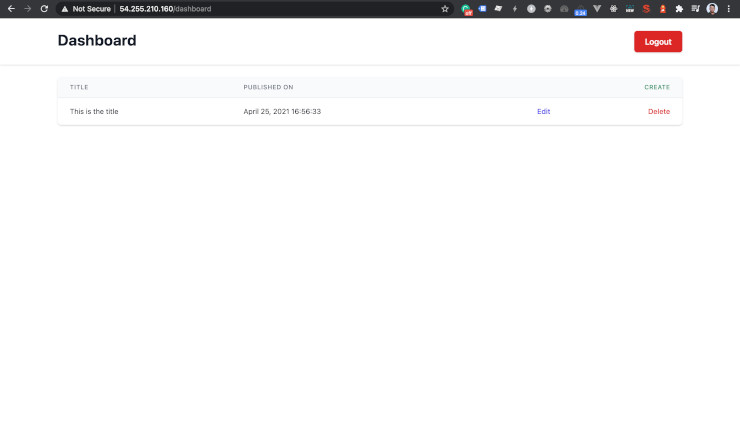1
2
3
4
5
6
7
8
9
10
11
12
13
14
15
16
17
18
19
20
21
22
23
24
25
26
27
28
29
30
31
32
33
34
35
36
37
38
39
40
41
42
43
44
45
46
47
48
49
50
51
52
53
54
55
56
57
58
59
60
61
62
63
64
65
66
67
68
69
70
71
72
73
74
75
76
77
78
79
80
81
82
83
84
85
86
87
88
89
90
91
92
93
94
95
96
97
98
99
100
101
102
103
104
105
106
107
108
109
110
111
112
113
114
115
116
117
118
119
120
121
122
123
124
125
126
127
128
129
130
131
132
133
134
135
136
137
138
139
140
141
142
143
144
145
146
147
148
149
150
151
152
153
154
155
156
157
158
159
160
161
162
163
164
165
166
167
168
169
170
171
172
173
174
175
176
177
178
179
180
181
182
183
184
185
186
187
188
189
190
191
192
193
194
195
196
197
198
199
200
201
202
203
204
205
206
207
208
209
210
211
212
213
214
215
216
217
218
219
220
221
222
223
224
225
226
227
228
229
230
231
232
233
234
235
236
237
238
239
240
|
package models
import (
"database/sql"
"log"
"time"
)
// User is a model for users.
type User struct {
ID int
Name string
Email string
Password []byte
}
// Article is a model for articles.
type Article struct {
ID int
Image string
Slug string
Title string
Content string
Author User
CreatedAt time.Time
}
var (
// Db is a database connection.
Db *sql.DB
// Err is an error returned.
Err error
)
// FindArticle is to print an article.
func FindArticle(slug string) *Article {
rows, err := Db.Query(`SELECT articles.image, articles.title, articles.content, users.name, articles.created_at FROM articles JOIN users ON users.id = articles.author WHERE slug = ?`, slug)
if err != nil {
log.Fatal(err)
}
defer rows.Close()
var createdAt []byte
user := &User{}
article := &Article{}
for rows.Next() {
err = rows.Scan(&article.Image, &article.Title, &article.Content, &user.Name, &createdAt)
if err != nil {
log.Fatal(err)
}
parsedCreatedAt, err := time.Parse("2006-01-02 15:04:05", string(createdAt))
if err != nil {
log.Fatal(err)
}
article.CreatedAt = parsedCreatedAt
article.Author = *user
}
return article
}
// Articles is a list of all articles.
func Articles() []*Article {
var articles []*Article
rows, err := Db.Query(`SELECT articles.id, articles.image, articles.slug, articles.title, articles.content, users.name, articles.created_at FROM articles JOIN users ON users.id = articles.author`)
if err != nil {
log.Fatal(err)
}
defer rows.Close()
for rows.Next() {
var (
id int
image string
slug string
title string
content string
author string
createdAt []byte
)
err = rows.Scan(&id, &image, &slug, &title, &content, &author, &createdAt)
if err != nil {
log.Fatal(err)
}
parsedCreatedAt, err := time.Parse("2006-01-02 15:04:05", string(createdAt))
if err != nil {
log.Fatal(err)
}
user := User{
Name: author,
}
articles = append(articles, &Article{id, image, slug, title, content, user, parsedCreatedAt})
}
return articles
}
// Find finds a user by email.
func (user User) Find() *User {
rows, err := Db.Query(`SELECT * FROM users WHERE email = ?`, user.Email)
if err != nil {
log.Fatal(err)
}
defer rows.Close()
for rows.Next() {
err = rows.Scan(&user.ID, &user.Name, &user.Email, &user.Password)
if err != nil {
log.Fatal(err)
}
}
return &user
}
// FindArticle finds an user article by ID.
func (user User) FindArticle(id int) *Article {
rows, err := Db.Query(`SELECT image, slug, title, content, created_at FROM articles WHERE id = ? AND author = ?`, id, user.ID)
if err != nil {
log.Fatal(err)
}
defer rows.Close()
var createdAt []byte
article := &Article{
ID: id,
Author: user,
}
for rows.Next() {
err = rows.Scan(&article.Image, &article.Slug, &article.Title, &article.Content, &createdAt)
if err != nil {
log.Fatal(err)
}
parsedCreatedAt, err := time.Parse("2006-01-02 15:04:05", string(createdAt))
if err != nil {
log.Fatal(err)
}
article.CreatedAt = parsedCreatedAt
}
return article
}
// FindArticles finds user articles.
func (user User) FindArticles() []*Article {
var articles []*Article
rows, err := Db.Query(`SELECT id, image, slug, title, content, created_at FROM articles WHERE author = ?`, user.ID)
if err != nil {
log.Fatal(err)
}
defer rows.Close()
for rows.Next() {
var (
id int
image string
slug string
title string
content string
createdAt []byte
)
err = rows.Scan(&id, &image, &slug, &title, &content, &createdAt)
if err != nil {
log.Fatal(err)
}
parsedCreatedAt, err := time.Parse("2006-01-02 15:04:05", string(createdAt))
if err != nil {
log.Fatal(err)
}
articles = append(articles, &Article{id, image, slug, title, content, user, parsedCreatedAt})
}
return articles
}
// Create creates a user.
func (user User) Create() *User {
result, err := Db.Exec("INSERT INTO users(name, email, password) VALUES(?, ?, ?)", user.Name, user.Email, user.Password)
if err != nil {
log.Fatal(err)
}
id, err := result.LastInsertId()
if err != nil {
log.Fatal(err)
}
if id != 0 {
user.ID = int(id)
}
return &user
}
// CreateArticle creates an article.
func (user User) CreateArticle(article *Article) {
_, err := Db.Exec(
"INSERT INTO articles(image, slug, title, content, author, created_at) VALUES(?, ?, ?, ?, ?, ?)",
article.Image,
article.Slug,
article.Title,
article.Content,
article.Author.ID,
article.CreatedAt,
)
if err != nil {
log.Fatal(err)
}
}
// UpdateArticle updates an article.
func (user User) UpdateArticle(article *Article) {
_, err := Db.Exec(
"UPDATE articles SET image = ?, slug = ?, title = ?, content = ? WHERE id = ? AND author = ?",
article.Image,
article.Slug,
article.Title,
article.Content,
article.ID,
user.ID,
)
if err != nil {
log.Fatal(err)
}
}
// DeleteArticle deletes an article.
func (user User) DeleteArticle(article *Article) {
_, err := Db.Exec(
"DELETE FROM articles WHERE id = ? AND author = ?",
article.ID,
user.ID,
)
if err != nil {
log.Fatal(err)
}
}
|

